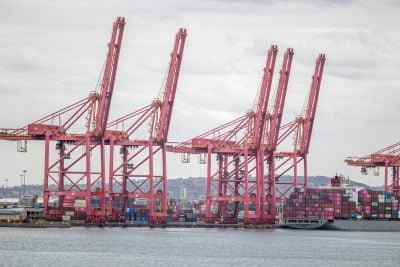The infrastructure that Africa’s ICT sector needs is steadily falling into place: “Governments across emerging African markets are modernising ICT infrastructure,” says Hagan from IDC. “Submarine cables such as Main One, Seacom, WACS, Glo-1, and ACE have improved internet penetration and adoption dramatically. Improved connectivity and connectivity infrastructure investments will continue to enhance hardware, software and IT services adoption.”
Africa’s ICT infrastructure has transformed dramatically over the last few years. In 2009, a Seacom undersea cable linked up South Africa, Mozambique, Tanzania and Kenya to international European and Asian routes. A year later the Eastern Africa Submarine Cable System delivered better connection to East Africa. The West African Cable System, concluded in 2012, did the same on the other end of the continent.
According to a 2013 report by Terabit Consulting, sub-Saharan Africa has witnessed the biggest growth in undersea capacity in the world: compound average growth over the last five years has been 71%. In contrast, the figure is just 27% for the transatlantic route.
According to Analysys Mason, investment in submarine cables in Africa has reached $3.8bn, generating new capacity of 24 Gbit/s while capital pumped into terrestrial networks has reached $8bn. Moreover seven countries which were without submarine cable leading stations in 2010 now have one at the very least.
Further improvements are on the horizon for Africa. A lot of the interest focuses on connecting the Lusophone African country Angola to Portuguese-speaking Brazil. Telebras, Brazil’s state-run telecommunications firm, and Angola Cables will build the 6,000 km connection between Fortaleza in Brazil and Luanda in Angola, aiming to finish construction by early to mid 2014.
This will mean improved connection for data and phone calls between South America and Africa, which currently have to travel via Europe and North America first. Data traffic costs should be slashed by as much as 80% as a result of the connection.
According to Antonio Nunes, chairman of Angola Cables: “It is a cable that will have a lot of demand, mainly because it will be the first undersea cable in the South Atlantic linking the two continents.”
Other projects in the pipeline include the construction of four new long-haul systems in West Africa and three on the eastern coast – projects which together will be worth $2.9bn. South Africa could also soon be linked to the other Brics countries Brazil, Russia, India and China through a $1.5bn 34,000 km undersea cable, which could be operational by the end of next year. However, large challenges remain. It is impossible for 16 landlocked countries in Africa even to reap the benefits for any given submarine landing station. According to Analysys Mason, these countries should focus on gaining access to cable landing stations in nearby countries or concentrate on bettering their terrestrial connectivity.
Aim is total connection
Several African countries are taking a number of measures to improve their ICT infrastructure. Kenya has plans to roll out its broadband and wireless networks as part of its Connected Kenya Masterplan.
The broadband strategy, announced in February, aims to deliver a 40Mbps connection to urban areas and a more modest 5Mbps connection to rural areas by 2017. Its aim is that by 2030, all sectors of the economy will be 100% connected. The country also has plans to develop a national cloud computing platform. Kenya is also committed to rolling out LTE in a $500m project.
Nigeria is also busy improving its infrastructure. The government is pursuing the ambitious target of quintupling internet broadband penetration by 2018. It is anticipated that 28 new base stations will be in place by the end of 2013.
Telecoms firms are believed to be pumping as much as $6bn into infrastructure over the next few years starting from 2013.
Meanwhile, Ethiopia is also making progress. The government has just agreed a $700m deal with Chinese telecoms firm Huawei which will see the rolling out of 3G across the country and 4G in the capital city, Addis Ababa. The target is 56m customers by 2015. It is a massive breakthrough in a country where until now there has only been a single mobile operator – Ethio Telecom.
Smaller countries are keen to work together to improve their mobile broadband. In September, Botswana, Lesotho, Tanzania, Mozambique, Malawi and Zambia pledged their common commitment to speeding up the roll-out of mobile broadband in their countries. The raft of measures they agreed on included the establishment of a Joint Task Force. It is hoped that the latter will spell tighter regional cooperation, which will, in turn, stimulate greater investment.
There has been a lot of buzz around the arrival of 4G in Africa. Angola hit the headlines last year when it emerged that Angolan firms were to benefit from 4G before their European counterparts, thanks to a $100m project by African GSM provider Movicel and Chinese mobile firm ZTE to bring 4G to the oil-rich Cabinda region and over a dozen urban areas.
G4 and cloud computing arrive
But, overall, industry experts are muted in their excitement about 4G’s potential uptake more widely across the region. “The potential for 4G in Africa is moderate,” says Spiwe Chireka, a programme manager at IDC. “To begin with, spectrum management and availability in Africa is the main bottleneck for the development of 4G services. Regulators are struggling to make the much-needed spectrum available and consequently limiting the pace and extent of 4G rollout in the region,” says Chireka.
“While service providers are refarming their existing 3G and other GSM spectrum to rollout 4G, the refarmed spectrum can only meet the traffic demands to a certain extent and the QoS (quality of service) is not so great depending on the amount of spectrum made available for the service. As a result, until spectrum issues are addressed, LTE services will remain a niche offering, available to a handful of customers and in key metropolitan areas in the major cities.”
Interest in integrating cloud computing into African ICT infrastructures is also building. “Improved fibre-optic cable access is enhancing connectivity services across Africa and is a definite factor in reducing the cost of doing business across various sectors. Easier and less costly access to the fibre infrastructure will drive adoption of connectivity services as well as investments in IT services,” says Hagan from IDC.
“We subsequently expect an opportunity for cloud services to emerge, provided that the cost of bandwidth decreases and the quality of connectivity improves significantly.”
David Meads, Cisco Vice-President for Africa, is also very positive about cloud computing’s future on the continent: “Cloud adoption in the African market is unquestionably gathering pace, with many service providers and enterprises currently considering deploying cloud-based networks, in one form or another,” he says. “While some companies are ahead in their cloud plans compared to others, there is in general a strong understanding among enterprises in the region of the power, benefits and advantages of moving towards the cloud. Cisco foresees that the Middle East and Africa will have the highest cloud traffic growth rate [79% CAGR (compound annual growth rate).”
However, finding a skilled workforce, which is also key to any ICT sector’s infrastructure, is an area which many African countries are struggling with. Even in South Africa, complaints that there is a shortage of skilled ICT labour are common. Last year, a survey by the South African ICT news site ITWeb found that two thirds of firms felt there was a lack of labour skilled in ICT.
Furthermore, a report by Nigeria’s BusinessDay newspaper recently found that the ICT sector ranked third in terms of labour shortage in the country. It also found that ICT qualifications will be the second-most-sought-after qualifications in Nigeria after engineering.
A study by the University of Nairobi School of Computing and Informatics found earlier this year that the country’s ICT sector is suffering from a skills mismatch – whereby ICT degree students are not learning the right skills for the job market and firms are hiring ICT graduates with the wrong skill sets for their companies’ needs.
Want to continue reading? Subscribe today.
You've read all your free articles for this month! Subscribe now to enjoy full access to our content.
Digital Monthly
£8.00 / month
Receive full unlimited access to our articles, opinions, podcasts and more.
Digital Yearly
£70.00 / year
Our best value offer - save £26 and gain access to all of our digital content for an entire year!
 Sign in with Google
Sign in with Google 


